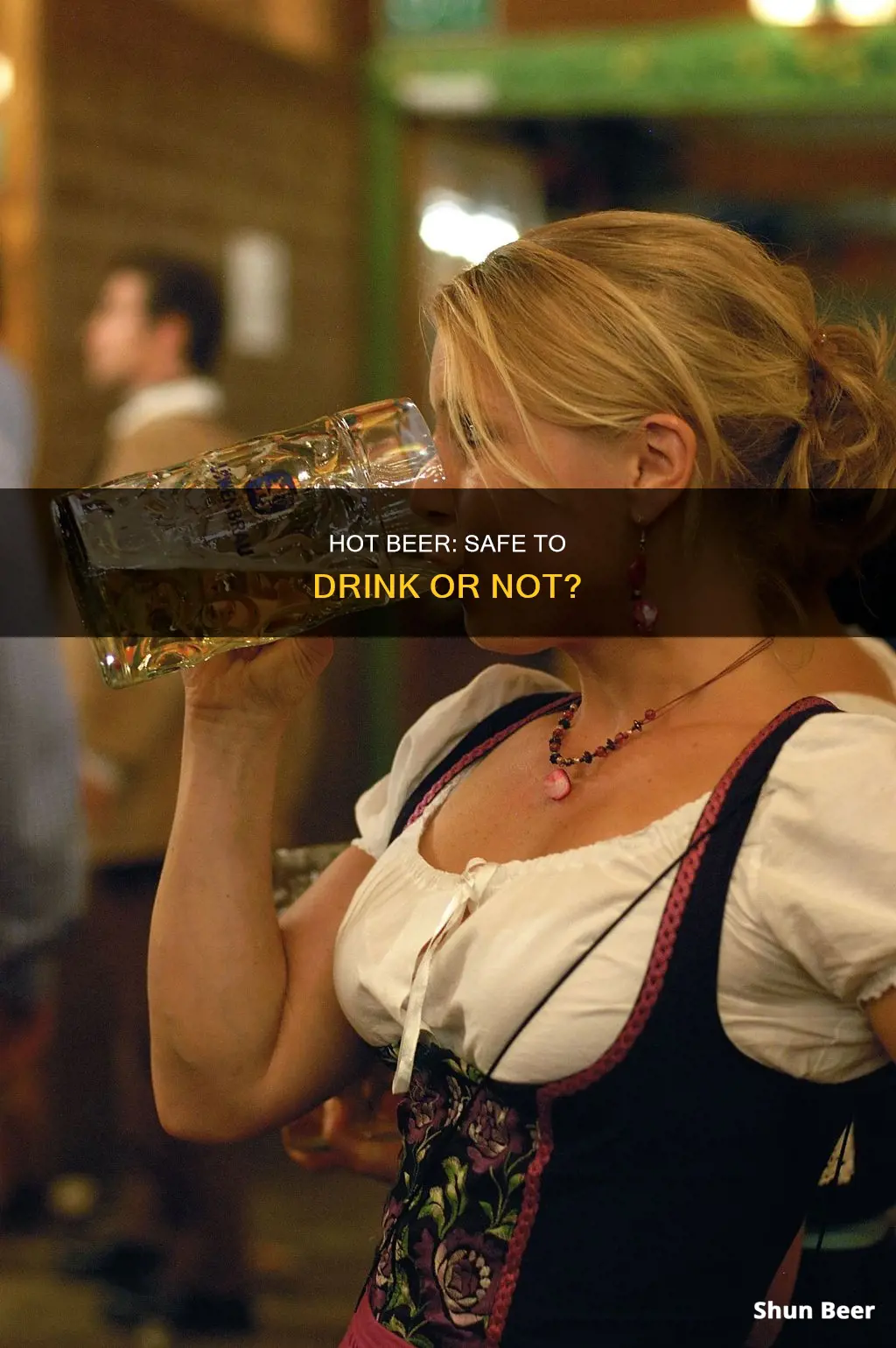
Drinking hot beer may seem like an unusual idea, but it was once the norm. From the early 1600s to the mid-1800s, hot beer was a staple of tavern life. In fact, drinking warm beer has been documented as far back as the dawn of civilisation. Today, it is widely believed that drinking beer ice-cold is the best way to enjoy it, but this is not necessarily the case. Many full-bodied ales are best enjoyed at nearly room temperature, as it allows their sweeter notes to shine through. In addition, chilling beer can dampen its flavour and increase carbonation, giving it a pleasant tingle that can mask the poor taste of watery lagers.
What You'll Learn

Hot beer was once popular and considered healthy
Drinking hot beer may seem like an unusual idea today, but it was once a popular and common practice. From the 1600s to the 1800s, hot beer was a staple of tavern life, and drinkers consumed it in staggering quantities. The preference for cold beer is a relatively recent development, driven by the advent of artificial refrigeration and the rise in popularity of lager beer, which is brewed to be consumed cold.
Hot beer, or "mulled" beer, was often infused with herbs and spices, and sometimes even cream and beaten eggs. It was considered to be a healthy drink, with people believing that it aided digestion and provided nourishment. This belief was based on the idea that the stomach was ruled by two "master-qualities" of heat and dryness, and that drinking cold beer would upset the balance of these qualities.
The practice of drinking hot beer was also influenced by the lack of mechanized refrigeration. Before refrigeration, beer was commonly served at cellar temperatures, which could vary with the seasons. In the winter, warm beer was welcomed as a pleasant and comforting distraction from the cold. Heating the beer also helped to mask the taste of substandard ingredients and questionable brewing techniques used in homebrews.
Today, the idea of drinking hot beer may be making a comeback, with a small handful of bars and breweries experimenting with hot beer options and modern twists on traditional hot beer drinks. While the health benefits of hot beer may no longer be a concern for most people, drinking it can still provide a pleasurable and comforting experience, especially during the cold winter months.
Flooded Beer Font: How Does It Work?
You may want to see also

The preference for cold beer is relatively new
The preference for cold beer is a relatively new phenomenon. In fact, drinking ice-cold beer is a practice that emerged around the same time as the advent of refrigeration. Before this, it was commonplace to drink beer at cellar temperature, which is warmer than the ice-cold beers we know today.
The earliest reference to "ice-cold beer" was found to be from Texas's Wild White Elephant Saloon, which boasted of having not only the best brands of whiskey but also "ice-cold beer" in 1887, when year-round ice production became possible. This was also around the time that lagers—introduced to America by German immigrants—became the country's dominant malt beverage.
The shift towards colder beers was driven by several factors. Firstly, the development of pasteurised bottling lines and refrigerated rail cars allowed lagers to be distributed over longer distances and reach larger markets. This made them more accessible and popular among American drinkers. Secondly, the advent of refrigeration and mass production made it possible to store and ship beer at colder temperatures, ensuring safe and consistent quality.
Prior to the 20th century, English and American drinkers predominantly consumed malty ales, which were often unchilled or even hot. These ales were prone to spoilage and bacterial invaders, so drinking them warm was a way to test their quality. Heated ale drinks were also considered more nutritious and healthier than cold beer. They were commonly consumed during chilly nights and provided warmth and nutrition when meals were scarce.
Today, the preference for cold beer is strongly influenced by marketing and popular culture. Beer marketers understand that consumers love their beer ice-cold and use this to their advantage in their advertising campaigns. Additionally, songs by popular artists like Pink and the Grateful Dead have contributed to the association of ice-cold beer with fun and enjoyment.
However, the craft beer movement has led to a growing appreciation for drinking beer at warmer temperatures. Craft beer enthusiasts argue that drinking beer slightly warmer enhances the flavour and allows drinkers to perceive the complex flavour profiles and nuances better. As a result, some drinkers are now choosing to drink their craft beers at temperatures closer to room temperature to fully appreciate the depth of flavours.
Beer and Zyrtec: A Safe Mix?
You may want to see also

Hot beer can be made at home
Firstly, gather your ingredients and equipment. You will need a fermenter, airlock, brew kettle, burner, siphon with tubing, cleaner, sanitizer, hydrometer, thermometer, and a wort chiller. For ingredients, you will need hops, grains or malt extract, yeast, and water.
Now, you're ready to start brewing! Begin by sanitising all equipment that will come into contact with the beer after the boil. Fill your brew kettle with 5 gallons of water and heat it to 170 degrees Fahrenheit. Add your specialty grains and let them soak for 30 minutes, maintaining a temperature of between 160-170 degrees Fahrenheit.
Next, add the malt extract and aroma hops to the solution and bring it to a boil. Keep it boiling for 90 minutes. After this, cool the mixture with your wort chiller. Transfer the cooled wort to the fermenter and add water to bring the level to 5 gallons.
Now, it's time to activate and pitch the yeast. Ferment the beer at a temperature of 68-70 degrees Fahrenheit. This process will take 1-2 weeks, as the yeast ferments the sugars to release carbon dioxide and ethyl alcohol.
After the main fermentation, add priming sugar for carbonation. You can then bottle or keg your beer. If bottling, fill the bottles an inch from the top and let them rest for 2-3 weeks at room temperature to ensure proper carbonation.
And that's it! You've made hot beer at home. Remember to take notes on what you like and dislike about your brew so you can adjust the process next time. Enjoy your homemade hot beer!
Beer Consumption: Safe After 5 Days?
You may want to see also

Cold beer can mask poor taste
Drinking hot beer is generally safe, and some sources even recommend it. However, it is important to note that the taste of beer can be affected by temperature.
According to Mark Garrison, writing for Slate, the idea that beer is best served ice-cold is a conspiracy propagated by mega-brewers to mask the poor taste of their watery lagers. By chilling the beer, they depress the flavour and add a pleasant tingle of carbonation. Garrison recommends serving wheat beers, pilsners, and other light beers at 40–45°F, dark styles like cask ales and imperial stouts at 50–55°F, and ambers and bocks somewhere in between.
Garrison's view is supported by scientific research. A study by the Chinese Academy of Sciences, published in the journal Matter, found that alcoholic beverages taste more or less "ethanol-like" at different temperatures. The temperature of the liquid changes how the water and ethanol form, creating either chain-like or pyramid-shaped clusters at the molecular level, which impacts the drink's taste. At low temperatures, the alcohol forms more pyramid-shaped structures around the water molecules, which is why we generally drink beer cold.
However, it's important to note that serving temperature depends on the style of beer. Sweeter beers like barley wines and imperial stouts are better when served at warmer temperatures (around 60°F), as it allows their sweet malty aroma to bloom over the bitter base notes. On the other hand, hoppy, bitter beers are better served cold to highlight their bitterness. Generally, light-bodied, low-alcohol beers are best consumed cold, while heavier, darker drinks are better at warmer temperatures.
Temperature Cycling Does Not Affect Beer Freshness
It is a common misconception that temperature cycling—when beer is warmed and then cooled again—ruins the beer. In reality, temperature cycling has little to no effect on beer freshness. If this were the case, all beer imported from Europe would be skunked before it even reaches store shelves. While temperature does affect beer, it is exposure to warm temperatures that can ruin it. Beer is best preserved when kept cold, and keeping it refrigerated will help maintain its flavour for much longer.
Drinking Beer in Public: Texas Law Explained
You may want to see also

Beer temperature affects flavour
The temperature at which beer is served can significantly impact its flavour. While personal preferences may vary, understanding how temperature influences the taste can help drinkers optimise their beer-drinking experience.
Flavour Volatility
Higher temperatures make many chemical compounds more volatile. These volatile compounds are more easily perceived as aromas and flavours. This is why hot coffee has a more powerful aroma than unground beans. Conversely, colder temperatures mute our ability to taste certain flavours. For example, cold ice cream tastes perfectly balanced, but melted ice cream can become overly sweet.
Flavour Perception
Our ability to taste different flavours does not change equally with temperature. Sweetness is the most affected, followed by bitterness, and then sourness. Warmer temperatures enhance the perception of sweetness, while colder temperatures accentuate bitterness. Therefore, serving temperature should be considered to ensure the desired flavours shine through.
Beer Styles and Serving Temperatures
The style of beer plays a crucial role in determining the optimal serving temperature. Lighter, low-alcohol beers, such as lagers and wheat beers, are typically served chilled, between 45-50°F (7-10°C). This temperature range helps to highlight the carbonation and crispness of these beers.
On the other hand, darker, fuller-bodied beers like stouts, porters, and barleywines are best served slightly warmer, around 55-60°F (13-16°C). This temperature range allows the complex flavours and aromas of these beers to fully express themselves. The higher temperature ensures that the desirable flavours are activated and detectable, providing a more well-rounded drinking experience.
Temperature Cycling and Beer Quality
Contrary to popular belief, temperature cycling (warming and then rechilling) beer does not significantly impact its freshness or quality. Beer imported from other regions often undergoes temperature changes during transportation, yet it remains fresh upon arrival. However, prolonged exposure to warm temperatures can reduce a beer's shelf life and affect its flavour within a couple of days. Therefore, it is generally recommended to store beer at cooler temperatures to maintain its freshness and the brewer's intended flavour profile.
Beer and Paracetamol: Safe Mix or Health Risk?
You may want to see also
Frequently asked questions
Yes, it is safe to drink hot beer.
Drinking hot beer was common in the past, especially during the winter months. Today, it is less common, but some people still enjoy it.
Drinking hot beer can be a comforting and pleasant experience, especially during cold weather. It can also aid digestion and provide variety to your drinking experience.
To make hot beer, you can heat the beer directly or add hot ingredients to it. Heating the beer directly can be done on a stove or in a microwave. Adding hot ingredients, such as spices, sugar, or cream, can also raise the temperature of the beer.







